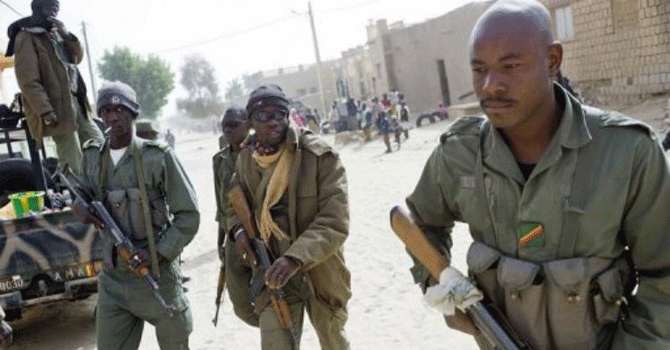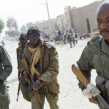
Royal Army of Sulu Seeks to Restore the Sultanate in Malaysia’s Sabah State
Publication: Terrorism Monitor Volume: 11 Issue: 7
By:

The Royal Army of Sulu (RAS) is a militant organization with an estimated 200 to 400 members that seeks to reinstitute the control of the historic Sultanate of Sulu over Malaysia’s Sabah State, in the northeastern region of the island of Borneo. RAS fighters claim fealty to the Manila-based Sultan Jamalul Kiram III, one of nine living claimants to the throne of Sulu. A majority of RAS fighters are members of the Tausug ethnic group, the majority ethnic group in the nearby Sulu Archipelago, an island chain belonging to the Philippines.
The Royal Army of Sulu (RAS) is a militant organization with an estimated 200 to 400 members that seeks to reinstitute the control of the historic Sultanate of Sulu over Malaysia’s Sabah State, in the northeastern region of the island of Borneo. On February 9, RAS fighters landed in Sabah from the southern Philippine islands near the busy Malaysian port city of Lahad Datu (Borneo Insider, February 14). On March 1, fighting between Malaysian security forces and the RAS broke out after several weeks of failed negotiations for the withdrawal of the RAS from Sabah. The fighting, which included air-strikes and mechanized raids by Malaysian security forces, is reported to have killed approximately 62 RAS fighters and ten members of the Malaysian soldiers (Philippine Daily Inquirer [Manila], March 17).
The Muslim Sultanate of Sulu was a small thalassocracy (a state based primarily on maritime territories such as islands and coastlines) dominated by the Tausug. Founded in the 15th century by the Arab explorer Sayyid Abu Bakr Abirin (later known as Paduka Mahasari Maulana al-Sultan Sharif al-Hashim), the Sultanate was based on the island of Jolo in the Sulu Sea southwest of the southern Philippine island of Mindanao. At its height, the Sultanate of Sulu controlled the islands of the Sulu Archipelago, Basilan Island, the southwestern peninsula of the Zamboaga region of the island of Mindanao and the northeastern region of the island of Borneo (currently Malaysia’s Sabah State).
In 1878, the Sultanate of Sulu either ceded or leased (there is a dispute over the exact translation of the agreement) control of its portion of northern Borneo to the British Northern Borneo Company for a yearly sum of money. The British claim to North Borneo was subsequently recognized by the Spanish colonial government in the Philippines, and in 1885 the Spanish relinquished their claim and the Sultan of Sulu’s claim to sovereignty over northern Borneo. The Sultanate of Sulu disregarded this Spanish action and has maintained its claim to Sabah to the present day. In 1946, the British made Sabah a crown colony.
Northern Borneo was incorporated into Malaysia upon Malaysia’s independence from Great Britain in 1963. Sabah joined the federation government of Malaysia on the condition that it was an autonomous state with powers of self-determination. The government of the Philippines still considers northeastern Borneo as part of the Philippines and the Malaysian government pays the descendants of the Sultanate of Sulu $1,700 a year as either rent or purchase of Sabah State, according to the interpretation of the 1878 agreement (Reuters, March 3). Sabah is estimated to have 11 trillion cubic feet of natural gas and 1.5 billion barrels of petroleum in both on and offshore reserves, equaling 25 percent and 12 percent of the Malaysia’s total natural gas and petroleum reserves (Reuters, November 15, 2011).
Sultan Jamalul III stated that the motivation for the invasion was his followers’ dissatisfaction with being left out of peace talks between the Philippine government and the Moro Islamic Liberation Front (MILF, the largest and most powerful Muslim political movement in the southern Philippines), which arrived at a draft agreement in October 2012 with Malaysia acting as a mediatory. Sultan Jamalul III stated that it was his perception that the Philippine government was ignoring him and unwilling to negotiate with Malaysia for reinstitution of the Sultanate in Sabah (Philippine Star [Manila], March 7).
RAS fighters are reported to be under the field command of Sultan Jamalul III’s brother and heir designate, Raja Muda Agbimuddin Kiram (Philippine Star [Manila], February 23). Malaysian security forces report that RAS fighters are utilizing nothing more powerful than assault rifles. It is believed that the RAS invaded Sabah by utilizing small speed boats operated from the southern Philippines island of Tawi-Tawi before infiltrating the region by exploiting family and social ties with Filipino Tausug immigrants (Daily Express [Kota Kinabalu], February 26).
Sabah has an estimated 800,000 Filipino immigrants who migrated to the state due to its proximity, common ethnic ties and Sabah’s expanding palm oil and construction industry. A significant number of Filipino immigrants in Sabah are reported to have received Malaysian citizenship under Malaysia’s former prime minister, Dr. Mahathir Mohammad, in exchange for Filipino political support for the ruling Barisan Nacional (BN) coalition. The current Malaysian government has begun the process of revoking the Malaysian citizenship of Filipino migrants who received it during Prime Minister Mohammad’s government (Manila Times, March 11). Since the outbreak of the conflict in Sabah, Malaysian security forces have reportedly been intimidating and arresting Filipino immigrants in Sabah forcing thousands of Filipinos to return to the Sulu Archipelago, prompting official condemnation from the Philippine government (Philippine Daily Inquirer [Manila], March 11).
As a result of the intensity of the Malaysian military’s campaign against the RAS, Sultan Jamalul III ordered RAS fighters to remain in Sabah and conduct guerilla warfare (The Philippine Star [Manila], March 18). Malaysian security forces predict that RAS fighters will create “pockets of resistance,” in rural villages in and around the Lahad Datu region and will be supported in this effort by sympathetic Suluk-Tausug villagers native to Sabah (Daily Tribune [Manila], March 19).
Politics of ethnic identity and intra-Moro political rivalries are also complicating factors in the conflict over Sabah. Factions of the Moro National Liberation Front (MNLF), a MILF rival and one of the most powerful political and military organizations in the Muslim-majority Autonomous Region of Muslim Mindanao (ARMM), are reported to be closely tied to the RAS invasion of Sabah. The MILF has been less militant in its rhetoric in support of the RAS than the Nur Misuari faction of the MNLF and supports a negotiated settlement between the Malaysian government and the RAS (Solar News [Manila], February 19). Misuari, the founder of the MNLF and leader what is reported to be its most powerful faction, recently accused the MILF of being an “instrument of Malaysian colonialism” (al-Jazeera, March 18).
Misuari and Muhajab Hashim, the head of the Islamic Command Council (ICC – the MNLF’s military wing), have stated that ICC members are “adherents” and “followers” of the Sultan, with the former adding that Sabah is “sacred land” for the Tausug (Philippine Star [Manila], March 7; al-Jazeera, March 18). The MNLF draws much of its membership from the Sulu Archipelago (Daily Tribune [Manila], March 6).
All factions of the MNLF have publicly stated their support for a negotiated peace between the RAS and the Malaysian government. Former and current fighters of the MNLF are also believed to be seeking to fight alongside the RAS in growing numbers (ABS-CBN News [Manila], March 5). Haji Musa Abdullah, a former MNLF commander, is reported to be the second most powerful officer in the RAS and the strategist who planned the Sabah invasion (The Star [Petaling Jaya], March 14).
Misuari is reported to have boasted to a Filipino general that the MNLF retained hundreds of fighters in Sabah and could control it in a couple of hours (Malaysia Today, March 13). MNLF leaders close to Misuari state that the MNLF maintained small arms caches throughout Sabah, a legacy of training the MNLF is alleged to have received from Malaysian security forces during the MNLF’s armed conflict with the Philippine government (1970-1996). MNLF fighters who lived in Sabah before the start of the fighting between the RAS and the Malaysian military are also stated to be recruiting local Filipino Tausug immigrants and native Suluk-Tausug to fight with the RAS (Manila Bulletin, March 5).
The conflict in Sabah raises questions over the possibility of competing foreign agendas between the government of the Philippines, Malaysia, the MILF and the MNLF and its political allies in the autonomous Bangsamoro region near Sabah. The MNLF’s ongoing operations against Abu Sayyaf Group in the Sulu islands and its support for the Royal Army of Sulu indicate that the MNLF is positioning itself to be an assertive force against its intra-Moro enemies and a source of support for its Moro allies in the Bangsamoro region, particularly in the restive Sulu island chains. The possibility of conflict between the Armed Forces of the Philippines and members of those movements seeking to fight in Sabah, particularly the MNLF, could add yet another complication to the already tenuous relations between the emerging Bangsamoro region (including Sabah) and the government of the Philippines.
Nicholas A. Heras is an independent analyst and consultant on Middle East issues and a former David L. Boren Fellow.





